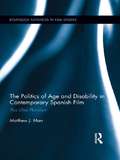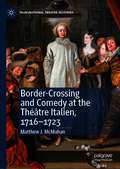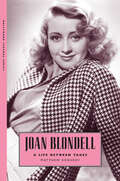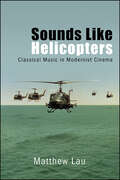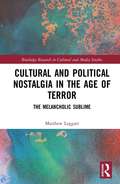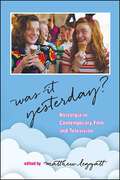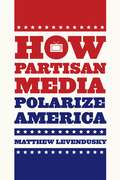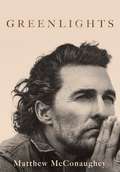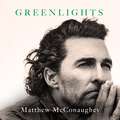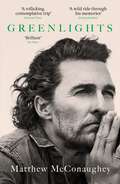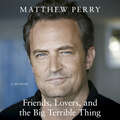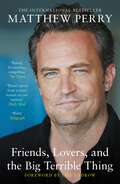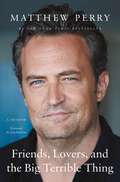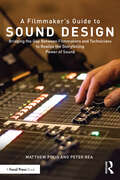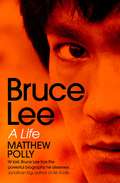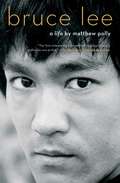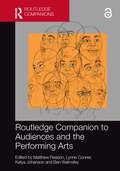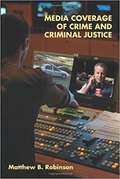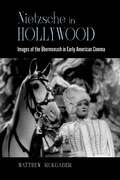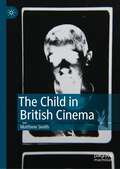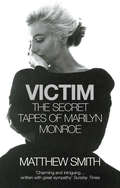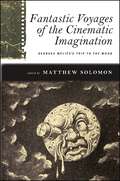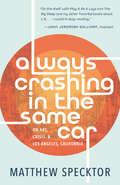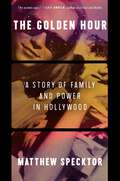- Table View
- List View
The Politics of Age and Disability in Contemporary Spanish Film: Plus Ultra Pluralism (Routledge Advances in Film Studies)
by Matthew J. MarrThe Politics of Age and Disability in Contemporary Spanish Film examines the onscreen construction of adolescent, elderly, and disabled subjects in Spanish cinema from 1992 to the present. Applying a dual lens of film analysis and theory drawn from the allied fields of youth, age, and disability studies, this study is set both within and against a conversation on cultural diversity—with respect to gender, sexual, and ethnic identity—which has driven not only much of the past decade’s most visible and fruitful scholarship on representation in Spanish film, but also the broader parameters of discourse on post-Transition Spain in the humanities. Presenting an engaging, and heretofore under-explored, interdisciplinary approach to images of multiculturalism in what has emerged as one of recent Spain’s most vibrant areas of cultural production, this book brings a fresh, while still complementary, critical sensibility to the field of contemporary Peninsular film studies through its detailed discussion of six contemporary films (by Salvador García Ruiz, Achero Mañas, Santiago Aguilar & Luis Guridi, Marcos Carnevale, Alejandro Amenábar, and Pedro Almodóvar) and supporting reference to the production of other prominent and emerging filmmakers.
Border-Crossing and Comedy at the Théâtre Italien, 1716–1723 (Transnational Theatre Histories)
by Matthew J. McMahanHow do nationalized stereotypes inform the reception and content of the migrant comedian’s work? How do performers adapt? What gets lost (and found) in translation? Border-Crossing and Comedy at the Théâtre Italien, 1716-1723 explores these questions in an early modern context. When a troupe of commedia dell’arte actors were invited by the French crown to establish a theatre in Paris, they found their transition was anything but easy. They had to learn a new language and adjust to French expectations and demands. This study presents their story as a dynamic model of coping with the challenges of migration, whereby the actors made their transnational identity a central focus of their comedy. Relating their work to popular twenty-first century comedians, this book also discusses the tools and ideas that contextualize the border-crossing comedian’s work—including diplomacy, translation, improvisation, and parody—across time.
Joan Blondell: A Life between Takes (Hollywood Legends Series)
by Matthew KennedyJoan Blondell: A Life between Takes is the first major biography of the effervescent, scene-stealing actress (1906-1979) who conquered motion pictures, vaudeville, Broadway, summer stock, television, and radio. Born the child of vaudevillians, she was on stage by age three. With her casual sex appeal, distinctive cello voice, megawatt smile, luminous saucer eyes, and flawless timing, she came into widespread fame in Warner Bros. musicals and comedies of the 1930s, including Blonde Crazy, Gold Diggers of 1933, and Footlight Parade. Frequent co-star to James Cagney, Clark Gable, Edward G. Robinson, and Humphrey Bogart, friend to Judy Garland, Barbara Stanwyck, and Bette Davis, and wife of Dick Powell and Mike Todd, Joan Blondell was a true Hollywood insider. By the time of her death, she had made nearly 100 films in a career that spanned over fifty years. Privately, she was unerringly loving and generous, while her life was touched by financial, medical, and emotional upheavals. Joan Blondell: A Life between Takes is meticulously researched, expertly weaving the public and private, and features numerous interviews with family, friends, and colleagues.
Sounds Like Helicopters: Classical Music in Modernist Cinema (SUNY series, Horizons of Cinema)
by Matthew LauExplores how modernist films use classical music in ways that restore the music's original subversive energy.Classical music masterworks have long played a key supporting role in the movies-silent films were often accompanied by a pianist or even a full orchestra playing classical or theatrical repertory music-yet the complexity of this role has thus far been underappreciated. Sounds Like Helicopters corrects this oversight through close interpretations of classical music works in key modernist films by Francis Ford Coppola, Werner Herzog, Luis Buñuel, Stanley Kubrick, Jean-Luc Godard, Michael Haneke, and Terrence Malick. Beginning with the famous example of Wagner's "Ride of the Valkyries" in Apocalypse Now, Matthew Lau demonstrates that there is a significant continuity between classical music and modernist cinema that belies their seemingly ironic juxtaposition. Though often regarded as a stuffy, conservative art form, classical music has a venerable avant-garde tradition, and key films by important directors show that modernist cinema restores the original subversive energy of these classical masterworks. These films, Lau argues, remind us of what this music sounded like when it was still new and difficult; they remind us that great music remains new music. The pattern of reliance on classical music by modernist directors suggests it is not enough to watch modernist cinema: one must listen to its music to sense its prehistory, its history, and its obscure, prophetic future.
Cultural and Political Nostalgia in the Age of Terror: The Melancholic Sublime (Routledge Research in Cultural and Media Studies)
by Matthew LeggattThis book re-examines the role of the sublime across a range of disparate cultural texts, from architecture and art, to literature, digital technology, and film, detailing a worrying trend towards nostalgia and arguing that, although the sublime has the potential to be the most powerful uniting aesthetic force, it currently spreads fear, violence, and retrospection. In exploring contemporary culture, this book touches on the role of architecture to provoke feelings of sublimity, the role of art in the aftermath of destructive events, literature’s establishment of the historical moment as a point of sublime transformation and change, and the place of nostalgia and the returning of past practices in digital culture from gaming to popular cinema.
Was It Yesterday?: Nostalgia in Contemporary Film and Television (SUNY series, Horizons of Cinema)
by Matthew LeggattBringing together prominent transatlantic film and media scholars, Was It Yesterday? explores the impact of nostalgia in twenty-first century American film and television. Cultural nostalgia, in both real and imagined forms, is dominant today, but what does the concentration on bringing back the past mean for an understanding of our cultural moment, and what are the consequences for viewers? This book questions the nature of this nostalgic phenomenon, the politics associated with it, and the significance of the different periods, in addition to offering counterarguments that see nostalgia as prevalent throughout film and television history. Considering such films and television shows as La La Land, Westworld, Stranger Things, and American Hustle, the contributors demonstrate how audiences have spent more time over the last decade living in various pasts.
How Partisan Media Polarize America
by Matthew LevenduskyForty years ago, viewers who wanted to watch the news could only choose from among the major broadcast networks, all of which presented the same news without any particular point of view. Today we have a much broader array of choices, including cable channels offering a partisan take. With partisan programs gaining in popularity, some argue that they are polarizing American politics, while others counter that only a tiny portion of the population watches such programs and that their viewers tend to already hold similar beliefs. <P><P> In How Partisan Media Polarize America, Matthew Levendusky confirms--but also qualifies--both of these claims. Drawing on experiments and survey data, he shows that Americans who watch partisan programming do become more certain of their beliefs and less willing to weigh the merits of opposing views or to compromise. And while only a small segment of the American population watches partisan media programs, those who do tend to be more politically engaged, and their effects on national politics are therefore far-reaching. <P>< In a time when politics seem doomed to partisan discord, How Partisan Media Polarize America offers a much-needed clarification of the role partisan media might play.
Greenlights: Raucous stories and outlaw wisdom from the Academy Award-winning actor
by Matthew McConaugheyFrom the Academy Award®-winning actor, an unconventional memoir filled with raucous stories, outlaw wisdom, and lessons learned the hard way about living with greater satisfaction.I've been in this life for fifty years, been trying to work out its riddle for forty-two, and been keeping diaries of clues to that riddle for the last thirty-five. Notes about successes and failures, joys and sorrows, things that made me marvel, and things that made me laugh out loud. How to be fair. How to have less stress. How to have fun. How to hurt people less. How to get hurt less. How to be a good man. How to have meaning in life. How to be more me.Recently, I worked up the courage to sit down with those diaries. I found stories I experienced, lessons I learned and forgot, poems, prayers, prescriptions, beliefs about what matters, some great photographs, and a whole bunch of bumper stickers. I found a reliable theme, an approach to living that gave me more satisfaction, at the time, and still: If you know how, and when, to deal with life's challenges - how to get relative with the inevitable - you can enjoy a state of success I call 'catching greenlights.'So I took a one-way ticket to the desert and wrote this book: an album, a record, a story of my life so far. This is fifty years of my sights and seens, felts and figured-outs, cools and shamefuls. Graces, truths, and beauties of brutality. Getting away withs, getting caughts, and getting wets while trying to dance between the raindrops.Hopefully, it's medicine that tastes good, a couple of aspirin instead of the infirmary, a spaceship to Mars without needing your pilot's license, going to church without having to be born again, and laughing through the tears.It's a love letter. To life.It's also a guide to catching more greenlights-and to realising that the yellows and reds eventually turn green too.Good luck.
Greenlights: Raucous stories and outlaw wisdom from the Academy Award-winning actor
by Matthew McConaugheyFrom the Academy Award®-winning actor, an unconventional memoir filled with raucous stories, outlaw wisdom, and lessons learned the hard way about living with greater satisfaction.I've been in this life for fifty years, been trying to work out its riddle for forty-two, and been keeping diaries of clues to that riddle for the last thirty-five. Notes about successes and failures, joys and sorrows, things that made me marvel, and things that made me laugh out loud. How to be fair. How to have less stress. How to have fun. How to hurt people less. How to get hurt less. How to be a good man. How to have meaning in life. How to be more me.Recently, I worked up the courage to sit down with those diaries. I found stories I experienced, lessons I learned and forgot, poems, prayers, prescriptions, beliefs about what matters, some great photographs, and a whole bunch of bumper stickers. I found a reliable theme, an approach to living that gave me more satisfaction, at the time, and still: If you know how, and when, to deal with life's challenges - how to get relative with the inevitable - you can enjoy a state of success I call 'catching greenlights.'So I took a one-way ticket to the desert and wrote this book: an album, a record, a story of my life so far. This is fifty years of my sights and seens, felts and figured-outs, cools and shamefuls. Graces, truths, and beauties of brutality. Getting away withs, getting caughts, and getting wets while trying to dance between the raindrops.Hopefully, it's medicine that tastes good, a couple of aspirin instead of the infirmary, a spaceship to Mars without needing your pilot's license, going to church without having to be born again, and laughing through the tears.It's a love letter. To life.It's also a guide to catching more greenlights-and to realising that the yellows and reds eventually turn green too. Good luck.The audiobook now includes an exclusive interview with Matthew McConaughey which was recorded during his book tour in 2021. (P)2020 Penguin Random House LLC
Greenlights: Raucous stories and outlaw wisdom from the Academy Award-winning actor
by Matthew McConaugheyFrom the Academy Award®-winning actor, an unconventional memoir filled with raucous stories, outlaw wisdom, and lessons learned the hard way about living with greater satisfaction.I've been in this life for fifty years, been trying to work out its riddle for forty-two, and been keeping diaries of clues to that riddle for the last thirty-five. Notes about successes and failures, joys and sorrows, things that made me marvel, and things that made me laugh out loud. How to be fair. How to have less stress. How to have fun. How to hurt people less. How to get hurt less. How to be a good man. How to have meaning in life. How to be more me.Recently, I worked up the courage to sit down with those diaries. I found stories I experienced, lessons I learned and forgot, poems, prayers, prescriptions, beliefs about what matters, some great photographs, and a whole bunch of bumper stickers. I found a reliable theme, an approach to living that gave me more satisfaction, at the time, and still: If you know how, and when, to deal with life's challenges - how to get relative with the inevitable - you can enjoy a state of success I call 'catching greenlights.'So I took a one-way ticket to the desert and wrote this book: an album, a record, a story of my life so far. This is fifty years of my sights and seens, felts and figured-outs, cools and shamefuls. Graces, truths, and beauties of brutality. Getting away withs, getting caughts, and getting wets while trying to dance between the raindrops.Hopefully, it's medicine that tastes good, a couple of aspirin instead of the infirmary, a spaceship to Mars without needing your pilot's license, going to church without having to be born again, and laughing through the tears.It's a love letter. To life.It's also a guide to catching more greenlights-and to realising that the yellows and reds eventually turn green too. Good luck.
Friends, Lovers and the Big Terrible Thing: 'A candid, darkly funny book' New York Times
by Matthew PerryThe beloved star of Friends takes us behind the scenes of the hit sitcom and his struggles with addiction in this candid, funny, and revelatory memoir that delivers a powerful message of hope and persistenceIn an extraordinary story that only he could tell, Matthew Perry takes readers onto the soundstage of the most successful sitcom of all time while opening up about his private struggles with addiction. Candid, self-aware, and told with his trademark humour, Perry vividly details his lifelong battle with the disease and what fuelled it despite seemingly having it all. Friends, Lovers, and the Big Terrible Thing is an unforgettable memoir that shares the most intimate details of the love Perry lost, his darkest days, and his greatest friends. Unflinchingly honest, moving, and hilarious: this is the book fans have been waiting for.(P)2022 Macmillan Audio
Friends, Lovers and the Big Terrible Thing: 'A candid, darkly funny book' New York Times
by Matthew PerryThe beloved star of Friends takes us behind the scenes of the hit sitcom and his struggles with addiction in this candid, funny, and revelatory memoir that delivers a powerful message of hope and persistence.'Hi, my name is Matthew, although you may know me by another name. My friends call me Matty. AndI should be dead.'So begins the riveting story of acclaimed actor Matthew Perry, taking us along on his journey from childhood ambition to fame to addiction and recovery in the aftermath of a life-threatening health scare. Before the frequent hospital visits and stints in rehab, there was five-year-old Matthew, who travelled from Montreal to Los Angeles, shuffling between his separated parents; fourteen-year-old Matthew, who was a nationally ranked tennis star in Canada; twenty-four-year-old Matthew, who nabbed a coveted role as a lead cast member on the talked-about pilot then called Friends Like Us. . . and so much more.In an extraordinary story that only he could tell - and in the heartfelt, hilarious, and warmly familiar way only he could tell it - Matthew Perry lays bare the fractured family that raised him (and also left him to his own devices), the desire for recognition that drove him to fame, and the void inside him that could not be filled even by his greatest dreams coming true. But he also details the peace he's found in sobriety and how he feels about the ubiquity of Friends, sharing stories about his castmates and other stars he met along the way. Frank, self-aware, and with his trademark humour, Perry vividly depicts his lifelong battle with addiction and what fuelled it despite seemingly having it all.Friends, Lovers, and the Big Terrible Thing is an unforgettable memoir that is both intimate and eye-opening - as well as a hand extended to anyone struggling with sobriety. Unflinchingly honest, moving, and uproariously funny, this is the book fans have been waiting for.
Friends, Lovers, and the Big Terrible Thing: A Memoir
by Matthew PerryINSTANT #1 NEW YORK TIMES BESTSELLER#1 INTERNATIONAL BESTSELLER The BELOVED STAR OF FRIENDS takes us behind the scenes of the hit sitcom and his struggles with addiction in this “CANDID, DARKLY FUNNY...POIGNANT” memoir (The New York Times) A MOST ANTICIPATED BOOK by Time, Associated Press, Goodreads, USA Today, and more!“Hi, my name is Matthew, although you may know me by another name. My friends call me Matty.”So begins the riveting story of acclaimed actor Matthew Perry, taking us along on his journey from childhood ambition to fame to addiction and recovery in the aftermath of a life-threatening health scare. Before the frequent hospital visits and stints in rehab, there was five-year-old Matthew, who traveled from Montreal to Los Angeles, shuffling between his separated parents; fourteen-year-old Matthew, who was a nationally ranked tennis star in Canada; twenty-four-year-old Matthew, who nabbed a coveted role as a lead cast member on the talked-about pilot then called Friends Like Us. . . and so much more.In an extraordinary story that only he could tell—and in the heartfelt, hilarious, and warmly familiar way only he could tell it—Matthew Perry lays bare the fractured family that raised him (and also left him to his own devices), the desire for recognition that drove him to fame, and the void inside him that could not be filled even by his greatest dreams coming true. But he also details the peace he’s found in sobriety and how he feels about the ubiquity of Friends, sharing stories about his castmates and other stars he met along the way. Frank, self-aware, and with his trademark humor, Perry vividly depicts his lifelong battle with addiction and what fueled it despite seemingly having it all. Friends, Lovers, and the Big Terrible Thing is an unforgettable memoir that is both intimate and eye-opening—as well as a hand extended to anyone struggling with sobriety. Unflinchingly honest, moving, and uproariously funny, this is the book fans have been waiting for.
A Filmmaker’s Guide to Sound Design: Bridging the Gap Between Filmmakers and Technicians to Realize the Storytelling Power of Sound
by Peter Rea Matthew PolisThis illuminating book offers a unique view into the art of sound design and the post production audio process. It was written for filmmakers and designed to bridge the creative gap between directors, producers and the artists, and technicians who are responsible for creating the full soundtrack. Building on over 50 years of combined expertise in teaching, filmmaking, and sound design, experienced instructor and author Peter Rea and sound designer Matthew Polis offer a cogent, clear, and practical overview of sound design principles and practices, from exploring the language and vocabulary of sound to teaching readers how to work with sound professionals and later to overseeing the edit, mix, and finishing processes. In this book, Polis and Rea focus on creative and practical ways to utilize sound in order to achieve the filmmaker's vision and elevate their films. Balancing practical, experienced-based insight, numerous examples, and unique concepts like storyboarding for sound, A Filmmaker’s Guide to Sound Design arms students, filmmakers, and educators with the knowledge to creatively and confidently navigate their film through the post audio process.
Bruce Lee: A Life
by Matthew PollyMore than forty years after Bruce Lee’s sudden death at age 32, journalist and author Matthew Polly has written the definitive account of Lee’s life. It’s also one of the only accounts; incredibly, there has never been an authoritative biography of Lee. Following a decade of research that included conducting more than one hundred interviews with Lee’s family, friends, business associates and even the mistress in whose bed Lee died, Polly has constructed a complex, humane portrait of the icon. There are his early years as a child star in Hong Kong cinema; his actor father’s struggles with opium addiction and how that turned Bruce into a troublemaking teenager who was kicked out of high school and eventually sent to America to shape up; his beginnings as a martial arts teacher, eventually becoming personal instructor to movie stars like Steve McQueen; his struggles as an Asian-American actor in Hollywood and frustration seeing role after role he auditioned for go to a white actors in eye makeup; his eventual triumph as a leading man; his challenges juggling a sky-rocketing career with his duties as a father and husband; and his shocking end that to this day is still shrouded in mystery. Polly breaks down the myth of Bruce Lee and argues that, contrary to popular belief, he was an ambitious actor who was obsessed with martial arts—not a great kung-fu master who just so happened to make a couple of movies. The book offers an honest look at an impressive yet flawed man whose personal story was even more entertaining and inspiring than any fictional role he played on-screen.
Bruce Lee: A Life
by Matthew PollyThe &“definitive&” (The New York Times) biography of film legend Bruce Lee, who made martial arts a global phenomenon, bridged the divide between eastern and western cultures, and smashed long-held stereotypes of Asians and Asian-Americans. Forty-five years after Bruce Lee&’s sudden death at age thirty-two, journalist and bestselling author Matthew Polly has written the definitive account of Lee&’s life. It&’s also one of the only accounts; incredibly, there has never been an authoritative biography of Lee. Following a decade of research that included conducting more than one hundred interviews with Lee&’s family, friends, business associates, and even the actress in whose bed Lee died, Polly has constructed a complex, humane portrait of the icon. Polly explores Lee&’s early years as a child star in Hong Kong cinema; his actor father&’s struggles with opium addiction and how that turned Bruce into a troublemaking teenager who was kicked out of high school and eventually sent to America to shape up; his beginnings as a martial arts teacher, eventually becoming personal instructor to movie stars like James Coburn and Steve McQueen; his struggles as an Asian-American actor in Hollywood and frustration seeing role after role he auditioned for go to a white actors in eye makeup; his eventual triumph as a leading man; his challenges juggling a sky-rocketing career with his duties as a father and husband; and his shocking end that to this day is still shrouded in mystery. Polly breaks down the myths surrounding Bruce Lee and argues that, contrary to popular belief, he was an ambitious actor who was obsessed with the martial arts—not a kung-fu guru who just so happened to make a couple of movies. This is an honest, revealing look at an impressive yet imperfect man whose personal story was even more entertaining and inspiring than any fictional role he played onscreen.
Josephine Baker and the Rainbow Tribe
by Matthew Pratt GuterlCreating a sensation with her risqué nightclub act and strolls down the Champs Elysées, pet cheetah in tow, Josephine Baker lives on in popular memory as the banana-skirted siren of Jazz Age Paris. In Josephine Baker and the Rainbow Tribe, Matthew Pratt Guterl brings out a little known side of the celebrated personality, showing how her ambitions of later years were even more daring and subversive than the youthful exploits that made her the first African American superstar. Her performing days numbered, Baker settled down in a sixteenth-century chateau she named Les Milandes, in the south of France. Then, in 1953, she did something completely unexpected and, in the context of racially sensitive times, outrageous. Adopting twelve children from around the globe, she transformed her estate into a theme park, complete with rides, hotels, a collective farm, and singing and dancing. The main attraction was her Rainbow Tribe, the family of the future, which showcased children of all skin colors, nations, and religions living together in harmony. Les Milandes attracted an adoring public eager to spend money on a utopian vision, and to worship at the feet of Josephine, mother of the world. Alerting readers to some of the contradictions at the heart of the Rainbow Tribe project--its undertow of child exploitation and megalomania in particular--Guterl concludes that Baker was a serious and determined activist who believed she could make a positive difference by creating a family out of the troublesome material of race.
Routledge Companion to Audiences and the Performing Arts (Audience Research)
by Matthew ReasonThe Routledge Companion to Audiences and the Performing Arts represents a truly multi-dimensional exploration of the inter-relationships between audiences and performance. This study considers audiences contextually and historically, through both qualitative and quantitative empirical research, and places them within appropriate philosophical and socio-cultural discourses. Ultimately, the collection marks the point where audiences have become central and essential not just to the act of performance itself but also to theatre, dance, opera, music and performance studies as academic disciplines. This Companion will be of great interest to academics, researchers and postgraduates, as well as to theatre, dance, opera and music practitioners and performing arts organisations and stakeholders involved in educational activities.
Media Coverage of Crime and Criminal Justice
by Matthew RobinsonMedia Coverage of Crime and Criminal Justice critically examines the media to identify how crime and criminal justice are treated in the news and entertainment media. The goal is not only to help shed light on important realities of crime and criminal justice in the United States but also to correct major misconceptions created by coverage of crime and criminal justice in the news, on television, in movies, in music, and other media forms. While there are other texts on the market focused on the impact of mass media on criminal justice, this text is the only one that starts with the issue of corporate ownership of the mass media as a potential problem for gaining an accurate understanding of the realities of crime and criminal justice. Further, this text presents basic information about the media in the introductory chapters and then applies this information to specific issues of crime and criminal justice in the rest of the book, thereby focusing on the same issues and themes throughout the book. Topics analyzed include how the media are organized, how they operate, and to what degree citizens are exposed to the media. Additionally, the book analyzes competing explanations of media coverage of crime and criminal justice, using examples from the real world to show why the media cover topics (and ignore others) the way they do. The book deals with media coverage of law-making and crime, policing, courts, and corrections. There are separate chapters of media coverage of each branch of criminal justice, with reviews of the literature focused on the most recent and influential research on these topics. The book also examines how the media both help and hinder effective crime control and crime prevention efforts. The book concludes with a summary of the book as well as suggestions for media reform, based on major findings of the book.
Nietzsche in Hollywood: Images of the Übermensch in Early American Cinema (SUNY series, Horizons of Cinema)
by Matthew RukgaberNietzsche in Hollywood offers a compelling and startling history of Hollywood film in which the German philosopher Friedrich Nietzsche and his idea of the Übermensch looms large. Though Nietzsche's philosophy was attacked as egoistic and a sociopathic version of Darwinism in films from the 1910s, it undergoes a series of cinematic and philosophical transformations in the 1920s and 1930s under the eye and pen of some of the most significant names in early Hollywood, including Erich von Stroheim, Josef von Sternberg, Ben Hecht, Howard Hawks, and Ernst Lubitsch. In addition to establishing historical connections between Nietzsche's philosophy and these filmmakers, the book provides philosophical readings of many Hollywood films through the lens of the Nietzschean ideas of "perspectivism" and the critique of morality. Offering a new history of classic Hollywood films as well as a new approach to film philosophy, Nietzsche in Hollywood reveals a reading of the philosopher in American culture that has largely been ignored.
The Child in British Cinema
by Matthew SmithThis book argues that over the twentieth and twenty-first centuries, the cinema in Britain became the site on which childhood was projected, examined, and understood. Through an analysis of these projections; via case studies that encompass early cinema, pre and post-war film, and contemporary cinema; this book interprets the child in British cinema as a device through which to reflect upon issues of national culture, race, empire, class, and gender. Beginning with a discussion of early cinematic depictions of the child in Britain, this book examines cultural expressions of nationhood produced via non-commercial cinemas for children. It considers the way cinema encroaches on the moral edification of the child and the ostensible vibrancy and vitality of the British boy in post-war cinema. The author explores the representational and instrumental differences between depictions of boys and girls before extending this discussion to investigate the treatment of migrant, refugee, and immigrant children in British cinema. It ends by recapitulating these arguments through a discussion of internationally successful British blockbuster cinema. The child in this study is a mobile figure, deployed across generic boundaries, throughout the history of British cinema and embodying a range of discourses regarding the health and wellbeing of the nation.
Victim
by Matthew SmithSuicide? Or murder? Marilyn Monroe's death in August 1962, apparently a suicide, shocked the world. A Hollywood star, a global icon, why would she have killed herself? Yet the coroner's report stated her death was due to a massive overdose of 47 Nembutal capsules. But what about the discrepancies between the official report and the scene of her death? What about the forensic evidence that went missing shortly after she died? Matthew Smith has constructed a startling new version of events. His interpretation is based not only on the full and true forensic evidence from the time, but also on the tapes that Marilyn made for her psychiatrist in the days and weeks before her death, tapes that portray a woman in full charge of her life and looking forward to a bright, busy, successful future. Forty years after her death, Marilyn remains an icon and a mystery. Matthew Smith's investigation into her death will lead to a new understanding of what really happened on the night of August 5th 1962 and in the weeks leading up to it.
Fantastic Voyages of the Cinematic Imagination: Georges Méliès's Trip to the Moon (SUNY series, Horizons of Cinema)
by Matthew Solomon"Best moving pictures I ever saw." Thus did one Vaudeville theater manager describe Georges Méliès's A Trip to the Moon [Le Voyage dans la lune], after it was screened for enthusiastic audiences in October 1902. Cinema's first true blockbuster, A Trip to the Moon still inspires such superlatives and continues to be widely viewed on DVD, on the Internet, and in countless film courses. In Fantastic Voyages of the Cinematic Imagination, leading film scholars examine Méliès's landmark film in detail, demonstrating its many crucial connecions to literature, popular culture, and visual culture of the time, as well as its long "afterlife" in more recent films, television, and music videos. Together, these essays make clear that Méliès was not only a major filmmaker but also a key figure in the emergence of modern spectacle and the birth of the modern cinematic imagination, and by bringing interdisciplinary methodologies of early cinema studies to bear on A Trip to the Moon, the contributors also open up much larger questions about aesthetics, media, and modernity.In his introduction, Matthew Solomon traces the convoluted provenance of the film's multiple versions and its key place in the historiography of cinema, and an appendix contains a useful dossier of primary-source documents that contextualize the film's production, along with translations of two major articles written by Méliès himself.
Always Crashing in the Same Car: On Art, Crisis, And Los Angeles, California
by Matthew Specktor"[An] absorbing and revealing book. . . nestling in the fruitful terrain between memoir and criticism." —Geoff Dyer, author of Out of Sheer Rage Blending memoir and cultural criticism, Matthew Specktor explores family legacy, the lives of artists, and a city that embodies both dreams and disillusionment. In 2006, Matthew Specktor moved into a crumbling Los Angeles apartment opposite the one in which F. Scott Fitzgerald spent the last moments of his life. Fitz had been Specktor’s first literary idol, someone whose own passage through Hollywood had, allegedly, broken him. Freshly divorced, professionally flailing, and reeling from his mother’s cancer diagnosis, Specktor was feeling unmoored. But rather than giving in or “cracking up,” he embarked on an obsessive journey to make sense of the mythologies of “success” and “failure” that haunt the artist’s life and the American imagination. Part memoir, part cultural history, part portrait of place, Always Crashing in the Same Car explores Hollywood through a certain kind of collapse. It’s a vibrant and intimate inspection of failure told through the lives of iconic, if under-sung, artists—Carole Eastman, Eleanor Perry, Warren Zevon, Tuesday Weld, and Hal Ashby, among others—and the author’s own family history. Through this constellation of Hollywood figures, he unearths a fascinating alternate history of the city that raised him and explores the ways in which curtailed ambition, insufficiency, and loss shape all our lives. At once deeply personal and broadly erudite, it is a story of an art form (the movies), a city (Los Angeles), and one person’s attempt to create meaning out of both. Above all, Specktor creates a moving search for optimism alongside the inevitability of failure and reveals the still-resonant power of art to help us navigate the beautiful ruins that await us all.
The Golden Hour: A Story of Family and Power in Hollywood
by Matthew SpecktorA personal and cultural exploration of the struggles between art and business at the heart of modern Hollywood, through the eyes of the talent that shaped itMatthew Specktor grew up in the film industry: the son of legendary CAA superagent Fred Specktor, his childhood was one where Beau Bridges came over for dinner, Martin Sheen’s daughter was his close friend, and Marlon Brando left long messages on the family answering machine. He would eventually spend time working in Hollywood himself, first as a reluctant studio executive and later as a screenwriter.Now, with The Golden Hour, Specktor blends memoir, cultural criticism, and narrative history to tell the story of the modern motion picture industry—illuminating the conflict between art and business that has played out over the last seventy-five years in Hollywood. Braiding his own story with that of his father, mother (a talented screenwriter whose career was cut short), and figures ranging from Jack Nicholson to CAA’s Michael Ovitz, Specktor reveals how Hollywood became a laboratory for the eternal struggle between art, labor, and capital.Beginning with the rise of Music Corporation of America in the 1950s, The Golden Hour lays out a series of clashes between fathers and sons, talent agents and studio heads, artists, activists, unions, and corporations. With vivid prose and immersive scenes, Specktor shows how Hollywood grew from the epicenter of American cultural life to a full-fledged multinational concern—and what this shift has meant for the nation’s place in the world. At once a book about the movie business and an intimate family drama, The Golden Hour is a sweeping portrait of the American Century.
